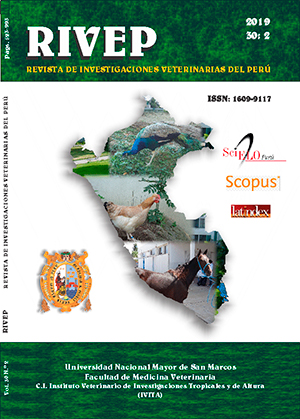Effect of inactivated feeder cells of two segments of the oviduct on the in vitro development of bovine embryos
DOI:
https://doi.org/10.15381/rivep.v30i2.16094Keywords:
mitomycin C; oviductual cells; feeder layer system; cellular inactivationAbstract
The aim of this study was to evaluate the effect of inactivated feeder cells (feeder layer system) from two segments of the bovine oviduct (isthmus and ampulla) in the in vitro development of bovine embryos. Cell lines from segments of the isthmus and ampulla were generated and subsequently inactivated with mitomycin C (40 μg/ml) to inhibit their ability to divide and eliminate competition for nutrients with embryos. Bovine oocytes were matured in vitro for 24 h and were fertilized for 18 h in conventional culture with Brangus bovine semen. The expected fertilized oocytes were cultured for seven days in the feeder layer system with isthmus and ampulla cells separately at a concentration of 1.44 x 10 5 cells/ml. The best results in the production of in vitro bovine embryos were obtained with ampullary cells (280/84, 30%) in comparison with the isthmus cells (278/75, 26.9%) and the control group (275/73, 26.5%) in a conventional system. It is concluded that the cells of the oviduct can fulfill functions like those that the oviduct fulfills in the in vivo process, improving the in vitro production of embryos.
Downloads
Downloads
Published
Issue
Section
License
Copyright (c) 2019 Gleni T. Segura, Marigeidy Santiago, Jenin V. Cortez, Nilton L. Murga

This work is licensed under a Creative Commons Attribution-NonCommercial-ShareAlike 4.0 International License.
AUTHORS RETAIN THEIR RIGHTS:
a. Authors retain their trade mark rights and patent, and also on any process or procedure described in the article.
b. Authors retain their right to share, copy, distribute, perform and publicly communicate their article (eg, to place their article in an institutional repository or publish it in a book), with an acknowledgment of its initial publication in the Revista de Investigaciones Veterinarias del Perú (RIVEP).
c. Authors retain theirs right to make a subsequent publication of their work, to use the article or any part thereof (eg a compilation of his papers, lecture notes, thesis, or a book), always indicating the source of publication (the originator of the work, journal, volume, number and date).










